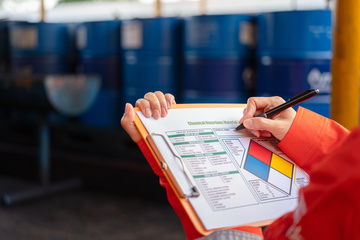Presented: Oct 29, 2025 Available until: Oct 31, 2026
Safety professionals are at the forefront of hazardous waste management, ensuring that organizations meet the rigorous standards required for the safe treatment, storage, and disposal of hazardous materials. This webinar is designed to equip OEHS professionals with essential knowledge of the Treatment, Storage, and Disposal Facility (TSDF) approvals process, regulatory requirements, and best practices.
Key Topics Covered:
TSDF Approvals Process:
Gain a comprehensive understanding of the step-by-step process for sending hazardous waste to a TSDF, including a technical review and assurance of disposal meeting requirements under the Resource Conservation and Recovery Act (RCRA).
Regulatory Compliance:
Explore the federal and state regulations that govern TSDF operations, with a focus on RCRA standards for permitting, facility operations, and safety. Learn how to navigate regulatory nuances to ensure ongoing compliance and avoid costly violations or penalties.
Documentation and Recordkeeping:
Understand the critical documentation required for hazardous waste management, including waste determinations, manifests, and land disposal notices. Learn best practices for maintaining accurate records to support compliance and facilitate inspections.
Best Practices for TSDF Management:
Discover strategies for safeguarding air, water, soil, and public health by preventing hazardous waste releases and contamination. The session will highlight emergency preparedness, proper storage, and operational controls that minimize environmental risks.
Role of Safety Professionals:
Examine the pivotal responsibilities of safety professionals in identifying hazardous waste, overseeing TSDF operations, and fostering a culture of safety and environmental stewardship within their organizations.
Objectives
Upon completion, participants will be able to:
- Identify RCRA hazardous waste
- Describe different treatment technology codes
- Discuss TSDF operations and capabilities for treatment
Lecturer
Emily Hawkins, CHMM
Ms. Hawkins is a Certified Hazardous Materials Manager and an accomplished hazardous waste professional with extensive experience spanning both government and private sectors. She is highly skilled in hazardous waste management and has a diverse background in the additional fields of water quality and fisheries biology. Emily is recognized for her strong commitment to quality assurance and holds a Bachelor of Arts in Biology from Green Mountain College. As the previous Chairwoman for The Consortium for Research and Education on Emerging Contaminants in Colorado, she led initiatives to advance research and education on critical environmental issues. Emily’s expertise and leadership make her a trusted voice in the field of hazardous waste management.
Credit
This course contains 1 hours of instruction. 0.1 CEUs are offered for this course.
As an IACET Accredited Provider, Bowen Learning Network offers CEUs for its programs that qualify under the ANSI/IACET Standard.
Eligible for contact hours with the BGC, BCSP, IHMM, and other OEHS certifying agencies.
For more details on certification and recertification credit, please visit How many points/credits/hours is a course worth?
Completion Requirements
To receive a Certificate of Completion for this course, participants are required to complete the following items:
- Participate in the live webinar or review the on-demand webinar recording.
- Score 70% or higher on the quiz.
- Complete the webinar evaluation.
No certificate will be awarded to participants who do not meet the above completion requirements.
Computer Requirements
The Bowen Learning Network online virtual classrooms are powered by BigBlueButton. It fully supports the Windows, Mac OS X, and Chromebook platforms (see below for versions supported). Support is available for iOS (iPads) and Android Tablets. While smart phones can be used, the screens are too small to display all of the aspects of the Virtual Classroom. For the best online learning experience, the use of a device with a larger screen is HIGHLY recommended. A physical keyboard is also recommended.
The Bowen EHS® Continuing Ed Package
Get access to all PDCs and Webinars in the package for one year and earn up to 50 contact hours.
See how the Virtual Classroom works:


